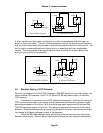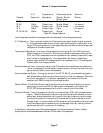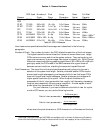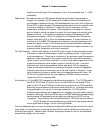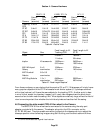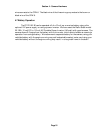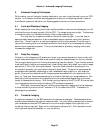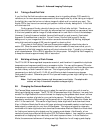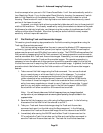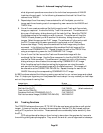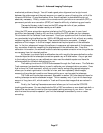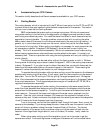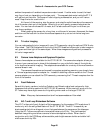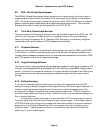Section 5 - Advanced Imaging Techniques
Page 34
5.4. Taking a Good Flat Field
If you find that flat field corrections are necessary due to vignetting effects, CCD sensitivity
variations, or for more accurate measurements of star magnitudes, try either taking an image of
the twilight sky near the horizon or take an image of a blank wall or neutral grey card. The
Kodak CCDs may have a low contrast grid pattern visible in the sky background. A flat field
will eliminate this.
Finding areas of the sky devoid of stars is very difficult after twilight. Therefore, you
should take flat field images of the night sky after sunset, but long before you can see any stars.
If this is not possible, take an image of a featureless wall or card held in front of the telescope.
However, if using this second method, be sure that the wall or card is evenly illuminated.
Appendix D describes how to do this. You will know if the flat field is good if the sky
background in your images has little variation across the frame after flat fielding, displayed
using high contrast (a range of 256 counts is good for showing this).
If you plan on flat fielding Track and Accumulate images you should also refer to
section 6.8. Since the same flat field is added to itself a number of times, be sure that you do
not saturate the flat field image by starting with pixel values too high. Typically try to keep the
pixel values between 10% to 20% of saturation for this purpose. For single flat field images, try
to keep the values to approximately 50% of saturation.
5.5. Building a Library of Dark Frames
The ST-7e/8E/9E have regulated temperature control, and therefore it is possible to duplicate
temperature and exposure conditions on successive nights. You can set the camera TE cooler
temperature to a value comfortably within reach on your average night, and then take and save
on disk a library of dark frames for later use. This is a good project for a rainy night. We
recommend you build a file of 5, 10, 20 ,40, and 60 minute dark frames at zero degrees
Centigrade for a start. Otherwise you will find yourself wasting a clear night taking hour long
dark frames!
Note: Dark frames taken the same night always seem to work better. The adaptive dark
subtract will help if the ambient temperature changes slightly.
5.6. Changing the Camera Resolution
The Camera Setup command allows you to select the resolution mode you wish to use for
taking and displaying images. The ST-7E/8E/9E cameras have High, Medium, Low and Auto
modes. The High Resolution mode is the best for displaying the greatest detail since it utilizes
the maximum number of pixels for your particular camera. The Medium Resolution Mode
operates by combining 2x2 pixels giving the same field of view as High Resolution Mode, but
with 1/4 the resolution. This results in significantly faster digitization and download times.
Also, in Medium Resolution Mode, with larger pixels and comparable readout noise there is a
better signal to noise ratio for very dim diffuse objects. This improved signal to noise ratio
combined with faster digitization and download times makes Medium Resolution Mode ideal
for finding and centering dim objects, and for imaging most objects. Additionally, a Low
resolution mode is provided which bins the CCD 3x3 before readout. Low resolution mode is
sensational for displaying faint nebulosity with short exposure times. In Auto Resolution
Mode, the camera and software will always use High Resolution for all imaging and display



